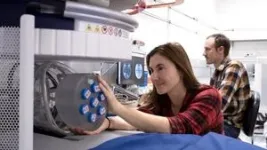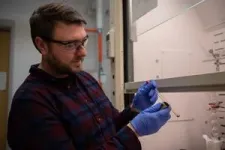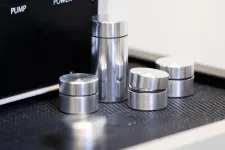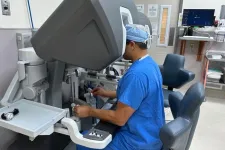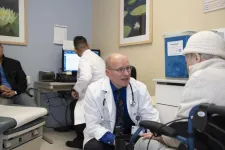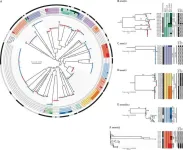(Press-News.org) Magnetic resonance imaging (MRI) machines can clearly view non-bony parts of the body — soft tissue such as the brain, muscles and ligaments — as well as detect tumors, making it possible to diagnose many diseases and other conditions. However, the powerful magnets in conventional MRI machines make them expensive and bulky, confining them mainly to hospitals and other large facilities.
As an alternative solution, companies are developing new portable versions that have lower-strength magnetic fields. These new models can potentially expand the ways in which MRI is used. For instance, low-field MRI systems could be deployed in ambulances and other mobile settings. They also could cost much less, promising to make MRI more widely available, including in underserved communities and developing nations.
But for low-field MRI scanners to reach their full potential, more research is needed to understand the relationship between low-field images and the underlying tissue properties they represent. Researchers at the National Institute of Standards and Technology (NIST) have been working on several fronts to advance low-field MRI technology and validate methods for creating images with weaker magnetic fields.
“Magnetic resonance images of tissue differ depending on magnetic strength,” said NIST electrical engineer Kalina Jordanova. “With low-field MRI systems, the contrast of the images is different, so we need to know how human tissue looks at these lower field strengths.”
Toward these ends, researchers measured the properties of brain tissue at low magnetic field strength. Their results were published in the journal Magnetic Resonance Materials in Physics, Biology and Medicine.
The researchers used a commercially available portable MRI machine to image brain tissue in five male and five female volunteers. The images were created using a magnetic field strength of 64 millitesla, which is at least 20 times lower than the magnetic field in conventional MRI scanners.
They collected images of the entire brain and obtained data on its gray matter (which has a high concentration of nerve cells), white matter (deeper tissues of the brain that house nerve fibers), and cerebrospinal fluid (clear fluid surrounding the brain and spinal cord).
These three brain constituents respond to the low magnetic field in different ways and produce distinctive signals that reflect their unique properties, enabling the MRI system to produce images that contain quantitative information about each constituent. “Knowing the quantitative properties of tissue allows us to develop new image collection strategies for this MRI system,” said NIST biomedical engineer Katy Keenan.
In separate work, NIST researchers are exploring several candidate materials that can significantly boost image quality in low-field MRI scans.
MRI contrast agents — magnetic materials that are injected into patients and enhance image contrast — make it easier for radiologists to identify anatomical features or evidence of disease and are routinely used in MRI at conventional magnetic field strengths. However, researchers are just starting to understand how contrast agents might be used with the new low-field MRI scanners. At the lower field strengths of these scanners, contrast agents may act differently than at higher field strengths, creating opportunities to use new types of magnetic materials for image enhancement.
NIST scientists and their colleagues compared the sensitivity of several magnetic contrast agents in low magnetic fields. The researchers found that iron oxide nanoparticles outperformed traditional contrast agents, which are made of the element gadolinium — a rare-earth metal. At low magnetic field strength, the nanoparticles provided good contrast using a concentration of only about one-ninth that of the gadolinium particles.
Iron oxide nanoparticles also offer the advantage that they are broken down by the human body instead of potentially accumulating in tissue, noted NIST researcher Samuel Oberdick. By comparison, a small amount of gadolinium may accumulate in tissue and could confound the interpretation of future MRI scans if it is not taken into account.
NIST researchers collaborated with the University of Florence in Italy and Hyperfine Inc. in Guilford, Connecticut, and reported their findings in the journal Scientific Reports.
END
New NIST measurements aim to advance and validate portable MRI technology
A new wave of smaller, less expensive, and portable MRI systems promises to expand the delivery of health care and the capabilities of medicine
2023-07-17
ELSE PRESS RELEASES FROM THIS DATE:
A key function for tight junctions in embryo models
2023-07-17
SAN FRANCISCO, CA—As a human embryo grows, a set of molecules directs cells as they multiply and take on specific identities and spatial positions within the embryo. In one crucial step known as gastrulation, these signaling molecules guide a single layer of embryonic stem cells to form three layers of distinct cell types that will later become different parts of the body.
Now, researchers in the iPS Cell Research Center at Gladstone Institutes have shown that tight junctions between cells may play a critical role in gastrulation in human embryos.
“This study has ...
COVID-19 case studies offer insights into what it will take to combat misleading medical information online
2023-07-17
1. COVID-19 case studies offer insights into what it will take to combat misleading medical information online
Health care leaders ‘take a shot’ at addressing viral medical rumors and disinformation
Abstract: https://www.acpjournals.org/doi/10.7326/M23-1218
URL goes live when the embargo lifts
A team of medical and public health leaders from the American Board of Internal Medicine, ABIM Foundation, and several respected institutions say COVID-19 case studies, among other ...
Rice engineers’ storage technology keeps nanosurfaces clean
2023-07-17
HOUSTON – (July 17, 2023) – Rice University engineers have created containers that can keep volatile organic compounds (VOCs) from accumulating on the surfaces of stored nanomaterials.
The portable and inexpensive storage technology addresses a ubiquitous problem in nanomanufacturing and materials science laboratories and is described in a paper published this week in the American Chemical Society journal Nano Letters.
“VOCs are in the air that surrounds us every day,” said study corresponding author Daniel Preston, an assistant professor in Rice’s Department of Mechanical Engineering. “They ...
Researchers discover group of genes that influence pain and brain communication can also influence alcohol use disorder risk
2023-07-17
INDIANAPOLIS—An estimated 16 million people in the United States have alcohol use disorders (AUDs), according to the National Institutes on Alcohol Abuse and Alcoholism (NIAAA). Now, Indiana University researchers have made a substantial discovery in the role genes play in the development of AUDs, finding that alteration of a group of genes known to influence neuronal plasticity and pain perceptions, rather than single gene defect, is linked to AUDs.
“We know inherited genes are a major contributor to this disease, because ...
MSK Research Highlights July 17, 2023
2023-07-17
New research from Memorial Sloan Kettering Cancer Center (MSK) and the Sloan Kettering Institute — a hub for basic science and translational research within MSK — identified a way to reduce toxicity in CAR T cell therapy; discovered a division of labor in DNA repair that suggests a possible therapeutic strategy for certain cancers; developed a new method to enable imaging of two PET tracers simultaneously; found biomarkers that could help predict outcomes in HER2-positive metastatic esophagogastric cancer; and made progress toward improving options ...
First robotic liver transplant in U.S. performed by Washington University surgeons
2023-07-17
A surgical team from Washington University School of Medicine in St. Louis recently performed the first robotic liver transplant in the U.S. The successful transplant, accomplished in May at Barnes-Jewish Hospital, extends to liver transplants the advantages of minimally invasive robotic surgery: a smaller incision resulting in less pain and faster recoveries, plus the precision needed to perform one of the most challenging abdominal procedures.
The patient, a man in his 60s who needed a transplant because of liver cancer and cirrhosis ...
Rice study: Men vastly outnumber women in studying legislative politics
2023-07-17
It’s no secret that men outnumber women in the halls of Congress and in other political arenas, but new research from Rice University, the University of Wisconsin-Madison and the University of Illinois Urbana-Champaign also found that significantly more men than women study the legislative process in the U.S. and abroad.
This has troubling implications for the inner workings of the discipline and the overall study of topics that impact women’s political involvement, according to Leslie Schwindt-Bayer, the Thomas Cooke and Mary Elizabeth Edwards Chair in Government and Democracy ...
City of Hope-led panel of experts updates cancer and aging guidelines issued by the American Society of Clinical Oncology
2023-07-17
LOS ANGELES — In an effort to improve treatment outcomes and quality of life for older adults with cancer, researchers from City of Hope, one of the largest cancer research and treatment organizations in the United States, and colleagues across the country today released updated guidelines by the American Society of Clinical Oncology (ASCO) outlining the need to assess and manage vulnerabilities in patients aged 65 and older prior to prescribing chemotherapy, targeted therapy and/or immunotherapy.
The updated recommendations, published in the Journal of Clinical Oncology, urges the clinical use of a validated geriatric assessment (GA) — defined as an evaluation ...
Survival of children with acute lymphatic leukemia further increased
2023-07-17
The five-year survival of all children with acute lymphatic leukemia (ALL) has continued to increase to 94%. This is evident from a study of 800 Dutch children. Within the study, modified treatment protocols for four subgroups were examined. The modifications were found to have positive effects on survival and quality of life. For example, the risk of disease recurrence became as much as three times smaller for children with an aggressive form of leukemia. Says Prof. Dr. Rob Pieters: ‘The five-year ...
Bacteria discreetly dwelling in throat revealed to be primary source of Strep A transmission
2023-07-17
Breakthrough research has found that Group A Streptococcus (GAS) infections are more likely transmitted from asymptomatic throat carriage than skin-to-skin contact in communities with high rates of infection.
This major discovery has far-reaching implications for public health approaches, vaccine development and future research as it challenges previous understanding of how the bacterium is spread.
GAS (Streptococcus pyogenes), commonly found on the skin and in the throat, can cause infections ranging from sore throats and impetigo (skin infections) to deadly bloodstream infections. In places like remote First Nations communities where the pathogen is ...
LAST 30 PRESS RELEASES:
Injectable breast ‘implant’ offers alternative to traditional surgeries
Neuroscientists devise formulas to measure multilingualism
New prostate cancer trial seeks to reduce toxicity without sacrificing efficacy
Geometry shapes life
A CRISPR screen reveals many previously unrecognized genes required for brain development and a new neurodevelopmental disorder
Hot flush treatment has anti-breast cancer activity, study finds
Securing AI systems against growing cybersecurity threats
Longest observation of an active solar region
Why nail-biting, procrastination and other self-sabotaging behaviors are rooted in survival instincts
Regional variations in mechanical properties of porcine leptomeninges
Artificial empathy in therapy and healthcare: advancements in interpersonal interaction technologies
Why some brains switch gears more efficiently than others
UVA’s Jundong Li wins ICDM’S 2025 Tao Li Award for data mining, machine learning
UVA’s low-power, high-performance computer power player Mircea Stan earns National Academy of Inventors fellowship
Not playing by the rules: USU researcher explores filamentous algae dynamics in rivers
Do our body clocks influence our risk of dementia?
Anthropologists offer new evidence of bipedalism in long-debated fossil discovery
Safer receipt paper from wood
Dosage-sensitive genes suggest no whole-genome duplications in ancestral angiosperm
First ancient human herpesvirus genomes document their deep history with humans
Why Some Bacteria Survive Antibiotics and How to Stop Them - New study reveals that bacteria can survive antibiotic treatment through two fundamentally different “shutdown modes”
UCLA study links scar healing to dangerous placenta condition
CHANGE-seq-BE finds off-target changes in the genome from base editors
The Journal of Nuclear Medicine Ahead-of-Print Tip Sheet: January 2, 2026
Delayed or absent first dose of measles, mumps, and rubella vaccination
Trends in US preterm birth rates by household income and race and ethnicity
Study identifies potential biomarker linked to progression and brain inflammation in multiple sclerosis
Many mothers in Norway do not show up for postnatal check-ups
Researchers want to find out why quick clay is so unstable
Superradiant spins show teamwork at the quantum scale
[Press-News.org] New NIST measurements aim to advance and validate portable MRI technologyA new wave of smaller, less expensive, and portable MRI systems promises to expand the delivery of health care and the capabilities of medicine

